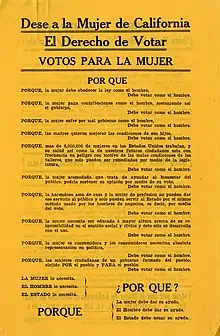Maria de Lopez
Maria Guadalupe Evangelina de Lopez (1881-1977) was a California suffragist and an educator from Los Angeles. In the 1910s, she campaigned and translated at rallies in Southern California, where suffragists distributed tens of thousands of pamphlets in Spanish.[1]
Maria de Lopez | |
|---|---|
| Born | 1881 |
| Died | 1977 |
| Education | Pasadena High School; Los Angeles Normal School |
| Known for | Women's suffrage activism |
| Parent(s) |
|
| Relatives | Ernestina de Lopez (sister) |
Early life
When she was a child, de Lopez lived in San Gabriel, Los Angeles. La casa Vieja de Lopez or La casa de Lopez de Lowther Adobe was the home for Juan Lopez, Maria de Lopez's father. He moved into this home in 1849.[2] Members of his family occupied the house until 1964, and when Maria de Lopez retired she lived in her ancestral adobe. The home is currently closed to the public.[3] Her father was a blacksmith, Juan Nepomiceno Lopez, and her mother was Guadalupe.[4] She had a sister named Ernestina de Lopez, who was also educated. The eldest daughter in her family, Belen, lived at home and worked as a seamstress and was not able to seek further education because she had to help at home. [4] By the 1890s, all of the older children in her family had left the house, and two sisters of Maria de Lopez had married and left home. This made it financially easier on the parents and made it possible for Maria and Ernestina de Lopez to stay in school.[4] When their father died in 1904, both sisters returned home to San Gabriel to live with their mother, and they supported her financially by working as Spanish teachers.[4]
Early career
Maria de Lopez had a long work history in the field of education. She was a teacher at Los Angeles High School, where she taught English as a second language course.[5] Maria de Lopez worked at the University of California, Los Angeles, as a translator.[6] In 1902, she became the youngest instructor at the University of California, making her possibly the first Latina to teach at UCLA.[7] In the 1930s, she served as president of the UCLA faculty women's club.[8]
Suffrage work

de Lopez was a member of the Los Angeles-based Votes for Women Club alongside Cora Lewis, Martha Salyer, Clara Shortridge Foltz, and Mary Foy which was formerly known as the Equality Club. On October 3, 1911, the Votes for Women Club held a large rally at the plaza, which featured Maria de Lopez giving her speech in Spanish. She was a member in Women's College Club, Women's Business Club, and the Executive Board of the high school teachers' association of Los Angeles.
She was also the president of the College Equal Suffrage League of Southern California when suffrage was won in 1911.[9] That year she published an article in the Los Angeles Herald calling for equal rights for women and men as foundational in a democracy.[10] The Los Angeles Herald also noted 1913 that de Lopez was chosen to be one of the suffragists representing California to march in the 1913 suffrage parade in Washington, D.C., organized by suffragists Alice Paul and Lucy Burns.[11] It is unknown if de Lopez attended the 1913 suffrage parade or not.[12]
de Lopez was a Spanish-language translator for the suffrage movement during the 1911 state-wide campaign.She "Instituted a campaign among the Spaniards and the Mexicans and toured the state giving suffrage lectures in Spanish."[5] Maria de Lopez is credited as the first person to make speeches in California on equal suffrage in the Spanish language. She also gave speeches on suffrage in English.[5]
Involvement in World War I
During World War I, Maria de Lopez temporarily gave up her teaching job and moved to New York City.[13] There she trained as an ambulance driver. She also learned to fly a plane and served in the ambulance corps in France. She was later cited for bravery by the French government.[4]
Personal life
Maria de Lopez was also known as Lupe, Eva, Maria, and Marie. In 1897 she graduated from Pasadena High School, and then she graduated from the Los Angeles Normal School, a teaching college. Maria de Lopez married Hugh Lowther, a professor at Occidental College. After marriage, she became Maria de Lopez Lowther or sometimes Maria de Lopez de Lowther.[14] The 1930 census said de Lopez was married at age 38.[15]
References
- Helton, Jennifer (15 August 2019). "Woman Suffrage in the West". National Park Service. Retrieved 27 September 2019.
- "Finding the Past | Living the Present". Finding History. 2019-05-11. Retrieved 2019-09-27.
- "Finding the Past | Living the Present". Finding History. 2019-07-07. Retrieved 2019-09-27.
- Wallis, Eileen (2010). Earning Power: Women and Work in Los Angeles, 1880-1930. University of Nevada Press. ISBN 9780874178135.
- "LOS ANGELES CITYWIDE HISTORIC CONTEXT STATEMENT Context: Women's Rights in Los Angeles" (PDF). Survey LA Los Angeles Historic Resources Survey. October 2018.
- "A Pasadena Latina". pasadenalatina.blogspot.com. Retrieved 2019-09-27.
- "Los Angeles Citywide Historic Context Statement: Women's Rights in Los Angeles" (PDF). October 2018.
- "UCLA Faculty Women's Club Presidents". uclafwc.bol.ucla.edu. Retrieved 2019-09-27.
- Leonard, John William (1914). Woman's Who's who of America: A Biographical Dictionary of Contemporary Women of the United States and Canada, 1914-1915. American Commonwealth Company. p. 499.
lopez.
- "Equal Suffrage of Most Vital Moment — Los Angeles Herald 20 August 1911 — California Digital Newspaper Collection". cdnc.ucr.edu. Retrieved 2020-03-30.
- "Los Angeles Herald 12 April 1913 — California Digital Newspaper Collection". cdnc.ucr.edu. Retrieved 2019-09-27.
- "Suffragists You Need to Meet: Maria Guadalupe Evangelina Lopéz". MyLO. 2020-04-28. Retrieved 2020-08-18.
- "1980.19.26 - Picture". theworldwar.pastperfectonline.com. Retrieved 2019-09-27.
- Martínez, Roberta H. (2009). Latinos in Pasadena. Arcadia Publishing. ISBN 9780738569550.
- Lopez, Maria (1930). "1930 Census".